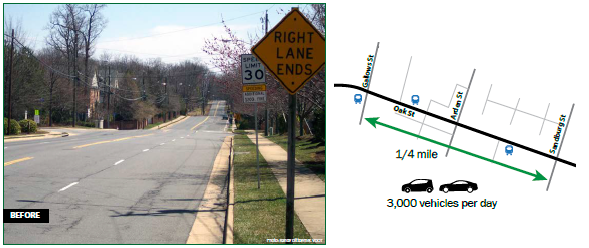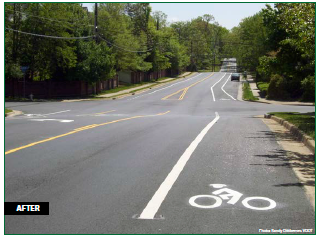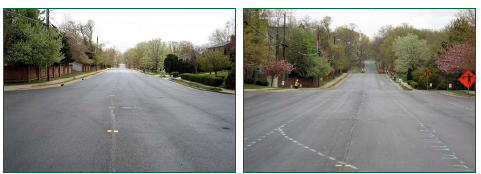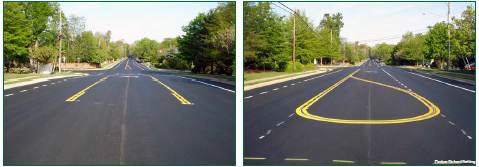IMPROVING SAFETY AND LIVABILITY
| Objective | Features | Results |
|---|---|---|
|
|
|


With hopes of providing a more consistent lane configuration and eliminating the most egregious speeding violations, the Virginia Department of Transportation (VDOT) implemented a Road Diet on a ¼-mile segment of Oak Street between Gallows Road and Sandburg Street.
Traffic volumes along this section of Oak Street are approximately 3,000 vehicles per day, and the surrounding neighborhood is mainly residential with single- and multi-family housing.

Oak Street after resurfacing and prior to installation of Road Diet markings

Oak Street after installation of Road Diet markings.
This roadway had an uncomfortable transition, and circumstances required an overlay due to wear. VDOT used that opportunity to fix the transition with a Road Diet, which also brought about safety and livability benefits.
BACKGROUND
Prior to the Road Diet, this 4-lane section of Oak Street ended abruptly just east of Sandburg Street, transitioning to a 2-lane roadway. This sudden lane drop often caused confusion for unfamiliar motorists in the area. In the 4-lane section, speeding and aggressive drivers often used the extra through lane in order to weave through traffic.
When a parallel street was temporarily closed for a bridge replacement, Oak Street absorbed a substantial increase in traffic volume, which accelerated the wear on its pavement. VDOT took advantage of the unplanned resurfacing to quickly design and implement a Road Diet, taking this 4-lane section of Oak Street to a 3-lane roadway with bicycle lanes and on-street parking.
RESULTS
While Oak Street had averaged less than a single crash per year in this short segment before the Road Diet was installed, VDOT is pleased to report that there have been no crashes in the first year following the project's completion in 2013.
"Through this Road Diet, we've been able to create center turn lanes, bike lanes, and on-street parking, all of which helped improve the safety and livability of the roadway," said Randy Dittberner of VDOT.
